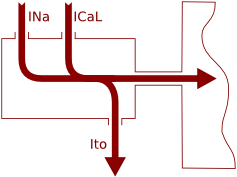Critical appraisal of the mechanism underlying J waves
Journal of Electrocardiology
46:390-394, 2013.
doi:10.1016/j.jelectrocard.2013.06.017
abstract
The identification of inferolateral J waves in a subgroup of idiopathic ventricular fibrillation (VF) patients has sparked great interest in the genesis of these waveforms. Inferolateral J waves were defined as a J point amplitude of ≥0.1 mV seen as slurring of the R wave or a positive deflection following the S wave of the QRS complex in inferior (II, III, aVF) or lateral leads (I, aVL, V4-V6). A single mechanism is thought to underlie both the J waves and the arrhythmias in these patients: the amplitude of the J waves is greater at the time of arrhythmic events and the ectopic beats preceding these events could frequently be mapped to the same ventricular region thought to be responsible for the J waves. It is therefore to be expected that the elucidation of the mechanism underlying these J waves will also clarify the associated arrhythmogenic substrate. Unfortunately, no local measurements are available to directly determine the mechanism underlying inferolateral J waves. It has recently been suggested that idiopathic VF patients with inferolateral J waves share an arrhythmogenic mechanism with Brugada syndrome patients. Such an overlap would be of interest as the pathophysiological mechanism of the Brugada syndrome is now becoming more and more clear. It has, however, not been univocally established that the same mechanism is operative in idiopathic VF patients. Thus, our understanding of the genesis of J waves is incomplete. In this paper we briefly discuss the genesis of electrocardiographic waveforms in general, potential mechanisms of J wave formation, and methods to differentiate these mechanisms.
context
This paper is part of the Symposium on J Wave Patterns and a J Wave Syndrome organized by Peter W. Macfarlane in Glasgow, August 2013. See also the introduction by the organizer and an editorial by Victor Froelicher and Galen Wagner.
